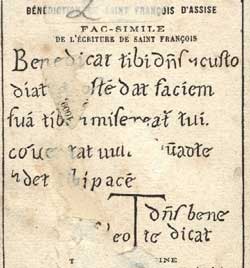 The TAU cross, a common symbol of the Franciscan Order is encountered all over Assisi.
The TAU cross, a common symbol of the Franciscan Order is encountered all over Assisi.
In the year 1215, Pope Innocent III called for a great reform of the Roman Catholic Church – the Fourth Lateran Council. The Pope opened the Council by recalling the Old Testament image of the TAU as taken from the Prophet Ezekiel (9:4):
‘Go through the city, through Jerusalem, and put a mark on the foreheads of those who sigh and groan over all the abominations that are committed in it.’ (NRSV)
“We are called to reform our lives, to come into the presence of God as righteous people. God will know us by the sign of the Tau on our foreheads.” (Wycliffe)
Although the Pope was probably recalling the Hebrew text of Ezekiel from a Greek translation of the Bible, the allegorical imagery as taken from the two different sources, was powerfully significant all the same.
In Old Testament times the image of the TAU, as the last letter for the Hebrew alphabet, meant that we were admonished to be faithful to God throughout our lives, until the last. Those who remained faithful were called the “remnant of Israel,” often the poor and simple people who trusted in God even without understanding the present distress or hardship in their lives.
This symbolic imagery, used by the Same Pope who commissioned the Order of Friars Minor a brief five years earlier, was immediately taken to heart by Saint Francis, who was in attendance at the Fourth Lateran Council.
The TAU, shaped like the letter “T” in the Greek alphabet could easily be identified with the cross of Christ and therefore, instead of signing his name, Francis would use the sign of the TAU as his signature and he painted in on the walls and doors of the places where he stayed. It was a further external gesture of his complete immersion in the passion of Christ. Francis honored and embraced the TAU cross as a reminder of his Crucified Lord and of his love for us. He instructed them to not only let that serve as a reminder, but also as an active symbol for them to be a walking crucifix in their lives.
Saint Bonaventure in his Legenda Major 4-9 sees the connection between the text from the prophet Ezekiel and the mission of Francis: “…according to the text of the prophet, in signing the TAU on those men who cry and weep as a sign of their sincere conversion to Christ.”
Another connection of Francis with the sign of the TAU is his service to the lepers and the Brothers of St. Anthony the Hermit who administered the lazzaretos. From the 3rd century, St. Anthony is known for carrying the TAU cross and is often pictured as having a staff surmounted by a TAU and on their habit was sewn the emblem of the TAU. The TAU of the Antonians, servants of the lepers, reminded Francis of that special moment in his conversion when he embraced the leper and he was devoted to that symbol of the “love of Christ, who willed to be considered a leper for our sake” (Fioretti 25).
Today, followers of Francis, as laity or religious, would wear the TAU cross as an exterior sign, a “seal” of their own commitment, a remembrance of the victory of Christ over evil through daily self-sacrificing love. The sign of contradiction has become the sign of hope, a witness of fidelity till the end of our lives.

Discussion
No comments yet.